CITY OF DREAMS SEASON-LONG INTERACTIVE SCULPTURE
FIGMENT Terrace Sculpture Garden
June 11 – October 3, 2010
Governors Island
FIGMENT has selected 16 wonderfully creative, interactive, and sustainable sculpture projects that have found a temporary home in our 2010 Sculpture Garden on Governors Island throughout the summer. In the FIGMENT Terrace Sculpture Garden, these highly interactive sculpture projects will be open and free for the public to engage with at all times the island is open, on Fridays from 10-4pm, Saturdays from 10-6pm, and Sundays from 10-6pm, from June 11 to October 3.
Please help us maintain these projects this summer by making a donation to FIGMENT.
These are the projects for 2010:
Touch by Bayard
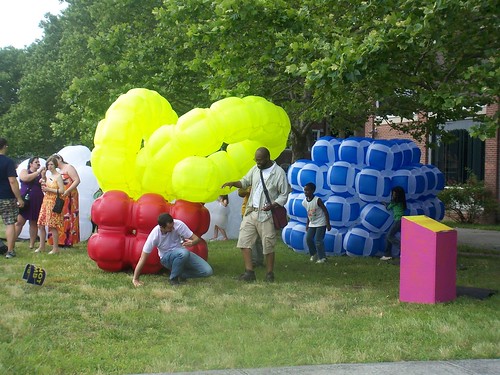
(c) 2010 Sara Muskulus
Touch consists of inflated pieces of silicone-impregnated rip stop nylon and nylon marine-quality thread that are filled with air by fans. Touch groups three inflatable pieces in a natural environment – an inflatable garden – as if they had grown there. The nature of the inflatable work begs the visitor to not just walk around and through the garden, but to turn from viewer to collaborator – and touch the artwork to begin to understand how something as flimsy as fabric becomes solid and erect.
Opto V by Chris Jordan
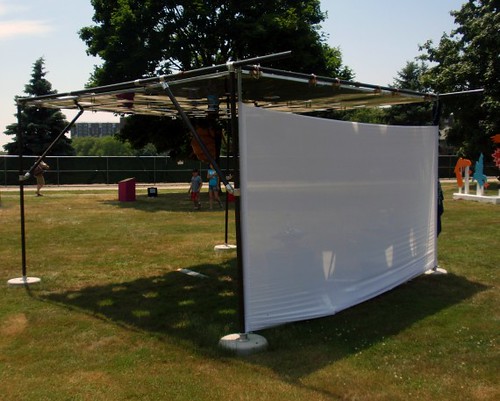
(c) 2010 Carlijn Urlings
Opto V creates optical interference from the sun. Its solar interference material is made of grid of holes projecting dots of light on the ground in the shadows of the installation. Beneath the interference structure are five unique objects in the form of simple childhood shapes (cubes, cones triangles), made from materials that interact with light: mirror, water, lens, colored gel, and film. As the earth rotates, the dots will move, passing over the light objects, causing a constant play of light. This ‘blinking’ of sunlight from afar will draw participants to the source. Using sunlight, 10-15 participants at a time can manipulate and reconfigure the objects, creating infinite temporal compositions. These solar refractions are directed towards a white mesh material affixed to the structure’s north face. Materials will be available for participants to create unique objects that will be integrated into the piece. Opto V offers a shared space to gather, tools to stimulate creative expression, and fosters a sense of unity through environmental awareness using ecological instruments.
Temple of Wonder by Jen Upchurch, Douglas Hart, and Bryan Cates
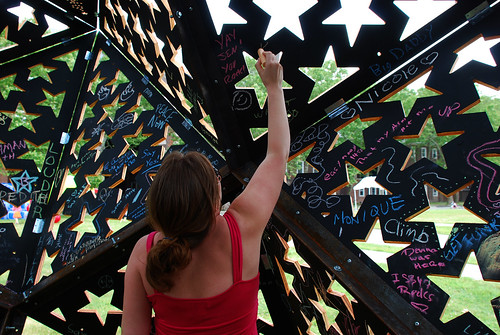
(c) 2010 NolaGrrlNYC
Designed in the shape of a three-dimensional star looking up to the sky, Temple Of Wonder is intended as a place of exploration, contemplation, reflection, and personal expression. Visitors are encouraged to walk through and sit down at its center, and interact with the temple’s structure by leaving contributions of art, messages, and other ephemera for public viewing on its wooden walls. Temple of Wonder asks the audience to respond to the questions ‘What does the future hold for us?’ and ‘What is it like to be in your own star?’ Temple of Wonder inspires visitors to interact with each other and marvel, be curious – be a star in their own way. As participants leave the temple, their silhouettes appear to leak from the corner of the eye like their own shining star. Following its installation on the island, the interactive elements of the project will transfer from the artists to the visitors who will react to, transform, and change the space in a more personal way.
1000 Pieces by ANIMUS Arts Collective
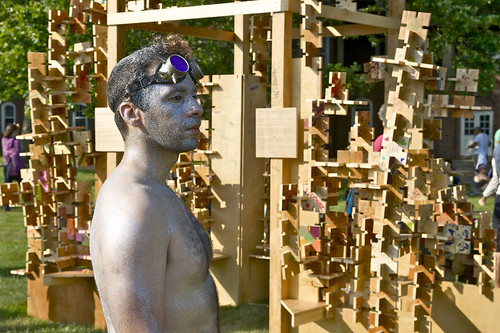
(c) 2010 Anna Kadysheva
The installation of 1000 Pieces – essentially a gazebo – is initially a simple rectangular wooden structure with seating around the perimeter and a roof atop four posts. Running up the height of the vertical posts are pieces of notched plywood. Inside the gazebo, on shelves mounted onto the posts, are stacks of square plywood pieces, also notched. The artwork evolves throughout the summer as passers-by become participants, taking a few pieces off the shelves and connecting them to the structure. Thus, a simple wooden gazebo will appear to be blossoming into color during the summer months. ANIMUS proposes that workshops be held and led by their members in two New York City public schools. The sculptures created by the students will be fastened on top of the structure to serve as the ‘crown’ and ‘chandelier’ of the gazebo. 1000 Pieces will create an environment that instigates a dynamic relationship between the participant and the object, and between the participants themselves.
1000 Pieces has received a 2010 grant from Black Rock Arts Foundation to fund a portion of the expenses associated with this project.
Squeegiabacus by Linda Byrne

(c) 2010 Carlijn Urlings
The abacus has been around for ages and can be considered the first calculator. Squeegiabacus is a giant child’s abacus installed almost entirely with re-used elements. It stands 65 inches tall – nearly 5.5 feet. It is interactive for children and adults of all ages, inviting visitors to bring it into play. The abacus is traditionally used to teach about counting, adding and subtracting, and it is a fun tool to develop motoring skills. Like a toy abacus, Squeegiabacus will consist of 10 rows of 10 moveable pieces. The giant abacus is shaped of 2×4 wood beams with metal rods holding the recycled blue squeegees that will be in place of the usual colored wooden balls.
A Lay in the Grass by Betsy Davis and Victoria Keddie

(c) 2010 Victoria Keddie
Find A Lay in the Grass on the Parade Grounds of Governors Island
Visitors of A Lay in the Grass lie on a bed, look up, gaze – and ignite a cognitive experience through the act of physical rest and an opening of the mind. A mattress of seeded grass (from a host rooftop garden in Brooklyn) fills the four-post bed frame. The sculptural bed can be seen as parallel to the imaginative play that transcends one’s conscious environment during the act of rest or dream. A Lay in the Grass joins the literal with the metaphor: the bed is a place for release, quiet, and the unconscious state of being. The installation itself reflects the state of Governors Island as a place of detachment, introspection, rest, and transmutation. The components of the installation speak of natural resources, symbolic elements, and surrealistic dreamscapes. A Lay in the Grass utilizes sustainable, recycled and organic materials, as the idea of the cycle is an important component to the overall work.
Living Lawn Furniture by Joe Sicignano and Marah Fellicce
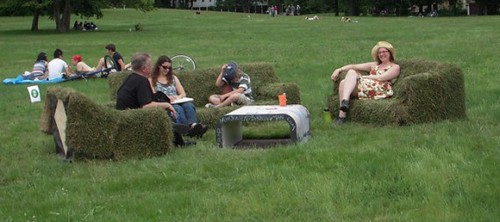
(c) Jim Glaser
Find Living Lawn Furniture on the Parade Grounds of Governors Island
Living Lawn Furniture is a set of earth-integrated sculptures intended to be installed early on Governors Island and morph with the environment. Integrating living edible plants, and other lawn substrates, ideally the seats will provide space for a tête-à-tête with another participant as well as raising awareness to Governors Island’s environment. The piece’s natural form (that of seats) provides a chance for reflection and discussion. The creation of the piece is interactive, starting immediately: the seedling project will involve anyone in New York City who is interested in nurturing plants on their windowsill. An enormous number of plants will be required, and the artists will be supplementing with an under layer of sod to ensure green coverage. The plants used will realize a garden on the sections of Living Lawn Furniture that do not receive heavy traffic (for example, the arms of the chairs). This living furniture could then be turned into an educational salad as part of the interactive/season-long programming on the island.
Fort Tree by Abby Goodman and Cindy Stockton-Moore

(c) 2010 qvixen
Fort Tree is a simultaneously private and public space into which visitors can project their own story. An interior, active display features real and fictional ‘specimens’ – adaptations of the flora and fauna of Governors Island. Featuring a variety of constructed chimera, the creatures in the displays and exterior sculpture point to both the multiplicity-of-use inherent in the structure and the spirit of make-believe it invokes. Participants of all ages are invited to create their own narrative by drawing and writing directly on the walls with the crayons, markers, and other donated writing tools on site. Built almost entirely from found and donated materials, Fort Tree gives new life to used or unwanted goods. Situated in the historic surroundings of Governors Island, Fort Tree is not only a shared space for invention and discovery; it also aims to re-define ideas of fortification – here, a fort is a structure for escape and play, designed to let things in rather than keep them out.
Sparky’s Wheel Of Tesla! by Kathleen and Jesse Green
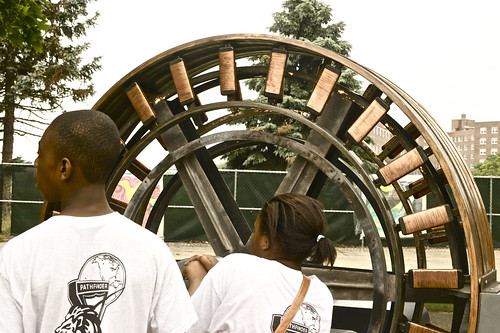
(c) 2010 Anna Kadysheva
In 1893 at the Columbian Exposition in Chicago, Nikola Tesla debuted ‘polyphase electrical power’ or what we now refer to as alternating current. Sparky’s Wheel Of Tesla! is an artistic representation of one of the many generators Tesla used to power the fair. While not an operational generator, Sparky’s Wheel Of Tesla! uses a manually powered rotor, hand cranked by participants, running steel brushes over a series of flints. Using an effect commonly found in children’s sparking toys, this will generate sparks against the coils that the participant can see, demonstrating the basic principles of how a generator creates and harnesses electricity. Molded primarily out of steel, PVC sheet and wood, Sparky’s Wheel Of Tesla! also incorporates reclaimed industrial materials, scrap metal, and scenic treatments to recreate the look and feel of Tesla’s original iron and copper devices. The main rings and rotors will be installed from scratch using new and recycled materials, while the axle and hand crank are found objects from old industrial equipment.
Pallet City by Katherine Gressel and Jeremy Reed

(c) 2010 Rebeka Bieber
Pallet City introduces a broad general public at Governors Island to the growing role of the pallet, and invites participation and feedback, simultaneously raising questions about practicality and aesthetics of pallet use. The linear installation, entirely built from recycled pallets, implies different activities that take place within the urban environment: sit (implied by a bench); park (a bike rack); dwell (a shelter); plant (a planter with small garden, which visitors can help water); perform (a stage where visitors can mount and document spontaneous performances, pose for photos etc.); observe (seats accompanying the theater); exhibit (a gallery space with 2-3 different exhibits that the artists will curate during the summer, and potentially a wall where visitors can put up their own small drawings); play (the rolling section), and learn (an ‘information kiosk’ at one end). Pallet City will thus describe the city in terms of active, democratic use rather than passive viewing or restricted areas. The project will ideally spark public dialogue on the notion of city itself and the creation of democratic, sustainable cities. Check out the Pallet City Blog!
Cicada by Johannah Herr
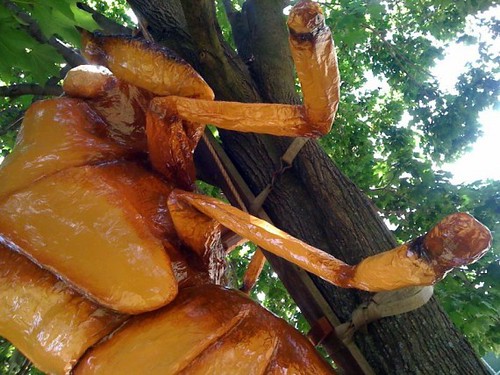
(c) 2010 Carlijn Urlings
Cicadas, with their deafening sound and their beautiful amber shells clinging to tree bark, are ultimately absent from our urban landscape, like parts of ourselves are often lost as a consequence of city-living. Cicada calls attention to this phenomenon by creating a larger than life cicada from recycled New York City newspapers shellacked and stretched over a chicken wire frame and mounted in a tree. The newspapers symbolically turn a mass-produced object familiar to the urban landscape into an organic, handmade object ironically unfamiliar despite its reference to an insect indigenous to the landscape long before the advent of concrete. At the base of the tree are handmade versions of a traditional Taiwanese toy which, when whirred by hand, mimic the sound of a cicada. There are also materials and instructions to make a toy yourself. Participants, in effect, bring Cicada to life through sound, and by keeping the toy they carry the sound of the cicada back to their own urban environment – thus revitalizing the cicada as part of NYC summers.
Process by Travis Mong

(c) 2010 Anna Kadysheva
580 interlocking pieces that each spin freely on their own axis, in colors that are visually pleasing and stunning at the same time. A visitor, or the wind for that matter, can spin one to all pieces of Process, transforming the piece at will to seemingly infinite possibilities. The visitor thus creates an abstract work of art – a color field. Process is a three dimensional piece that is viewed in a perceived two dimensional perspective. It exists between the tangible 3D object and the representational and illusionistic space of a painting. Much like our own cognitive process it embodies both perceived truth and tangible knowledge. It represents and conveys a shared experience the world over.
World Lair by Natalie Giugni
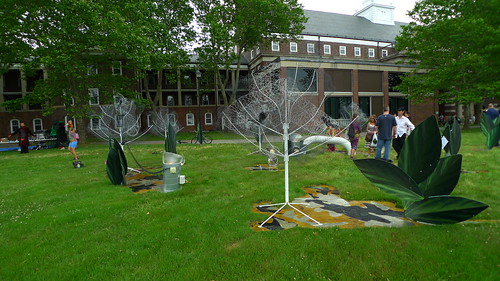
(c) 2010 Christian and Dian
World Lair is a commemoration of mankind’s universal need of a nurturing safe haven in which to develop. Visitors to the surreal dreamscape walk through a protective grove of trees harboring a multitude of nests suspended from branches and dens burrowed into hilly mounds. Tucked within, are groups of soon-to-be hatchlings represented by eggs displaying various states of being. Some lie in serene slumber as others boast open mouths eager for nourishment. Interspersed throughout these colonies, multicultural items can be found, revealing international domesticity and mankind’s common need of protection. Visitors of the World Lair will be encouraged to drop small personal artifacts into the dens and weave their own messages into the framework of the nests, thus mirroring the collective habits of birds to bring back objects to the nests in order to attract mates and feed their young.
Flock to LIVING by Living Company in collaboration with Johan Kritzinger

(c) 2010 Carlijn Urlings
Flock to LIVING is an installation that represents a call for all experiential representatives of LIVING, and stands as a beacon for representatives to come together in sharing their own insight on LIVING. Flock to LIVING utilizes a composition of multiple abstracted bird silhouettes, manifesting as painted and sculptural elements, and will come to Governors Island this summer after its debut on the Brooklyn Bridge during the winter of 2009/2010. LIVING company would like you to think of experience as what happens in the space between two destinations; it is the journey, and for LIVING company, we would like to emphasize the journey, not the destination.
M.O.R.E. Drums by Andrzej Liguz
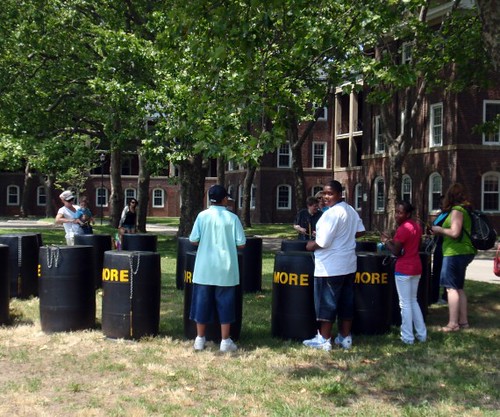
(c) 2010 Carlijn Urlings
M.O.R.E. (Ministry Of Random Events) was started in Australia by Andrzej Liguz in 1996. The M.O.R.E. Drums made their first American appearance at last year’s FIGMENT and are back this year as part of the FIGMENT Terrace Sculpture Garden. Visitors to the island are invited to play the twenty plastic industrial drums (generally used to transport shampoo etc.) as each drum has a pair of metal drumsticks attached for that purpose. It only needs one or two people to hold a solid rhythm and everybody can play around that beat, creating a primordial tribal experience in the heart of New York. To find out more about M.O.R.E., check their website or Facebook page.
Exquisite Weapon by Chris Niederer and Alex Roediger
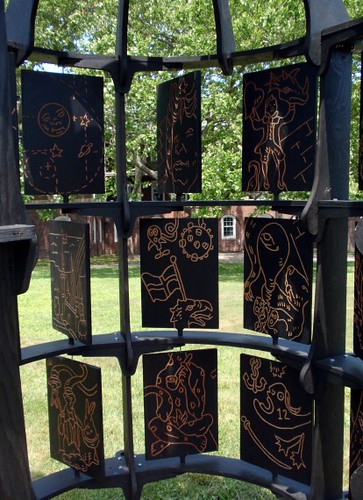
(c) 2010 Carlijn Urlings
The Exquisite Weapon evokes Governors Island’s historical and transformative nature. The unexploded bomb illustrates a temporary interruption in the destructive nature of creation. Its skin is composed of two-sided cartoon-like illustrations evokes the dual nature of the island, its military significance and future ecological harmony. The interior allows the user to rearrange the skin’s narrative into their own preferred juxtaposition of the horror of war and an Eden-like beatitude. The weapon’s tail displays a rotating teleidoscope to experience the view of a seed falling to earth – or the path of a bomb bent on destruction.
